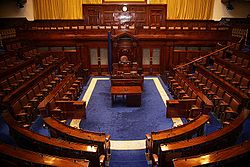Dáil Éireann (Irish Free State)
| Dáil Éireann | |
|---|---|

|
|
| Type | |
| Type | |
| History | |
| Established | December 6, 1922 |
| Disbanded | December 29, 1937 |
| Preceded by | Second Dáil |
| Succeeded by | Dáil Éireann |
| Leadership | |
| Structure | |
| Seats | 128 (1922–23) 153 (1923–37) 138 (1937) |
|
Length of term
|
5 years |
| Elections | |
|
|
| Meeting place | |
 |
|
| Dáil Chamber, Leinster House, Dublin | |
| Constitution | |
| Constitution of the Irish Free State | |
Dáil Éireann served as the directly elected lower house of the Oireachtas of the Irish Free State from 1922 to 1937. The Free State constitution described the role of the house as that of a "Chamber of Deputies". Until 1936 the Free State Oireachtas also included an upper house known as the Seanad. Like its modern successor, the Free State Dáil was, in any case, the dominant component of the legislature; it effectively had authority to enact almost any law it chose, and to appoint and dismiss the President of the Executive Council (prime minister). The Free State Dáil ceased to be with the creation of the modern 'Dáil Éireann' under the terms of the 1937 Constitution of Ireland. Both the Dáil and Seanad sat in Leinster House.
Under the Free State constitution membership of Dáil Éireann was open to all citizens who had reached the age of twenty-one. However those who were legally disqualified or who were members of the Seanad were excluded. For most of the period of the Irish Free State the constitution also contained a controversial requirement that all members of the Oireachtas swear an oath of fidelity to the King, as well as an Oath of Allegiance to the constitution of the Free State. The oath was, however, abolished by a constitutional amendment in 1936.
As today, during the Irish Free State Dáil Éireann was elected on the basis of universal adult suffrage. However the franchise was restricted to those over twenty-one. As adopted the constitution required that a Dáil's term would last for four years, unless the law specified a shorter period or the house was dissolved early. However, after changes to the constitution and the law in 1927, the constitutional maximum became six years, and the legal maximum five1. The Dáil could theoretically have been dissolved at any time by the King, acting on the advice of Executive Council, but it is probable that the Free State would have broken all constitutional ties if that had happened.
...
Wikipedia
